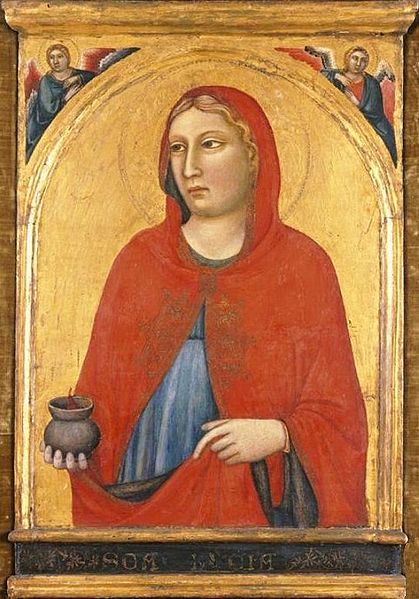On December 13th of every year we remember the life and death of Saint Lucy. Lucy was the virgin martyr who was put to death in the year 304 during the great persecution started by the Emperor Diocletian.
St. Lucy is one of those saints whose feast day came at the time of the winter solstice, and because the name Lucy is derived from the Latin “lucis or lux” which means “light” a song was written that had this refrain: “This is the feast of St. Lucy Light, the shortest day and the longest night.” In the 6th century, with the advent of Pope Gregory the Great’s liturgical reforms, her feast day lost that significance and concentrated on the manner of her death.
The legend of St. Lucy’s martyrdom centers on the fact that she was a Sicilian maiden who had vowed perpetual virginity in honor to God; however, complicating this vow was the fact that her father had promised her in marriage to a Roman citizen.
When she told the man of her determination to remain unmarried, he accused her before the governor of being a Christian. Since being a Christian was, at that time a capital offense, she was sentenced to death. Her executioners tried to burn her alive but according to eyewitnesses that attempt, remarkably, didn’t work.
Roman executioners were especially known for their sadistic brutality (the Empire believed it made more of a psychological statement to the masses), so they then decided to gouge out her eyes and put her to the sword.
She is artistically portrayed as either holding her eyes on a plate or in a small container. This is the way she is painted in the image below by Jacopo del Casentino (also known as Jacopo Landino), a Florentine painter working in the early 1330’s. He was the student of Taddeo Gaddi, who in turn had been the student of Giotto. Tragically, Jacopo’s son Francesco Landino was blind, yet, overcame this major challenge in his life (maybe with the help and intercession of St. Lucy?!) and became a successful composer.
In this painting you see St. Lucy portrayed with her eyes restored, while at the same time holding her severed eyes in the cup. Del Casentino was attempting to portray Lucy in an eschatological way, in other words, being present with God in Heaven.
In Heaven, her spiritual eyes are fully functional, yet, she is still holding her severed physical eyes to give testimony and witness to her heroic martyrdom for the Christian faith. Del Casentino, painting in what the Western Rite of the Catholic Church would call the Gothic period (AD 1100 – 1400), correctly shows her in a red cloak, symbolic of her martyrdom, while her inner tunic is blue – symbolic of her holiness/sainthood. Similar to the Iconographic period, the background is pure gold leaf, symbolic of Heaven itself.
Nine years after her execution, in AD 313, the Edict of Milan stated that Christians could worship freely and without any persecution. Lucy’s body was then brought to the Roman emperor Constantine’s new capital city – Constantinople (present day Istanbul, Turkey). In the early 13th century, after the Crusaders sacked Constantinople, her relics were brought to Venice where they presently rest in the Church of San Geremia.
Because of the manner of her torture she is the patron saint of the blind, and all those with ailments of the eyes. She is also the patron saint of the Venetian gondoliers, who because of their devotion to her wrote the famous song – Santa Lucia – which would be sung to their patrons as the ferried them around the canals of Venice. The song, however, is also claimed by the boatmen of the Bay of Naples who also, according to custom, sing it as they ferry people and cargo around the Bay.
The celebration of St. Lucy’s feast day is still common in Scandinavia and Italy and is celebrated with festivals of light and special St. Lucy cakes, resembling a frosted “Danish Twist” with candles on it. A recipe for such a cake can be found here at the Women For Faith and Family website: http://www.wf-f.org/stlucy.html.
It is interesting that the Church chose the Gospel about the bridesmaids with their oil lamps to accompany this feast of Saint Lucy. For our Gospel speaks about preparation. It asks us whether we, as Christians, are really focused on what is most important in life: our faith-filled devotion to the Lord, willingness to suffer for Him, and preparation for His return.
At a time when Christians needed encouragement to patiently and heroically suffer for their faith, her example led many others to witness to the faith in the same way. We all need heroes, and the saints as uniquely Christian heroes show us how to live, and sometimes, how to die for our faith.
Copyright © 2012 Deacon Paul O. Iacono All Rights Reserved


Thanks for your support to everyone there at Big Pulpit!
LikeLike
Thank you for this and all of your posts. I was able to see the incorrupt body of St. Lucy years ago when we were passing through Venice. It was a very special moment to be that close to such a devoted saint.
LikeLike
Thank you very much for your prayers and support.
Yes, that was a great privilege for you to be so close to the relics of such a beautiful saint. Pope John 23rd had her face covered with a silver mask, however, for being over 1700 years old her body looks mummified and has not completely decomposed – certainly this is a wonder for both science and theology.
LikeLike